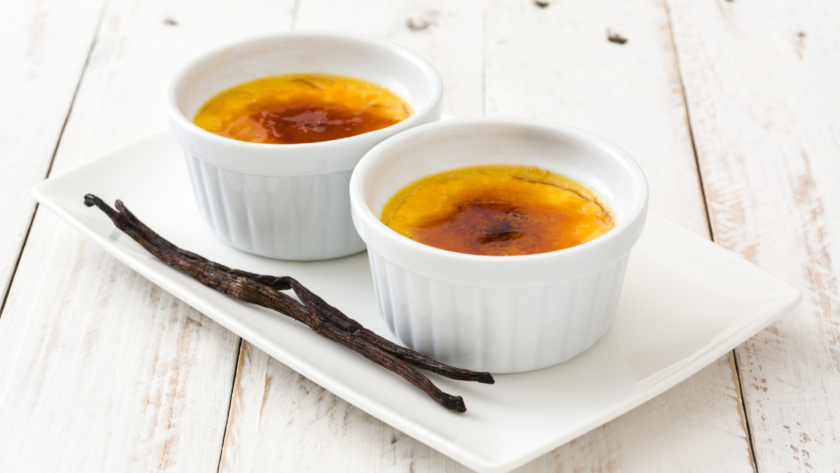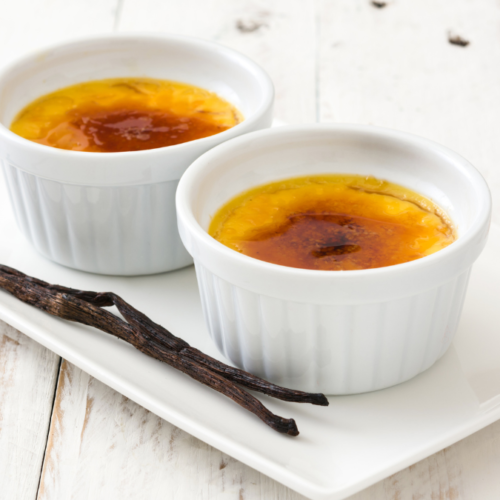The classic French dessert crème brûlée, with its rich, creamy custard foundation and the appealing contrast of crackling caramelized sugar on top, is the pinnacle of elegance and richness. This recipe will help you make this delicious dessert that is guaranteed to impress all of your guests.
Ingredients
- Egg Yolks: The egg yolks provide richness, smoothness, and contribute to the custard’s texture. They also act as a thickening agent for the custard.
- Granulated Sugar: Sugar sweetens the custard. When mixed with the egg yolks, it creates a smooth, creamy texture. Additionally, it helps with browning the sugar topping for that signature caramelized crust.
- Heavy Cream: The heavy cream is the primary base of the custard. It adds richness, creaminess, and a velvety texture to the dessert.
- Vanilla Extract or Vanilla Bean: Vanilla enhances the overall flavor profile, adding a beautiful aromatic essence to the custard. Vanilla extract or vanilla bean seeds infuse the cream with its distinctive flavor.
- Salt: A pinch of salt helps balance the sweetness and enhances the flavors, providing a subtle depth to the custard.
Tips
- For a richer flavor, you can use a combination of vanilla extract and vanilla bean seeds.
- Be cautious while caramelizing the sugar to avoid burning it. Keep the torch or broiler a few inches away from the sugar.
- The custards can be prepared a day in advance and caramelized just before serving to maintain the crispness of the sugar topping.
How to make Crème Brulée
- Preheat Oven: Preheat your oven to 325°F (160°C). Place a kettle of water on the stove to boil for the water bath.
- Prepare Ramekins: Arrange the ramekins in a deep baking dish and set aside.
- Prepare Custard Base:
- In a mixing bowl, whisk together the egg yolks and granulated sugar until the mixture becomes thick and pale yellow.
- In a saucepan, pour the heavy cream and add the vanilla extract or vanilla bean seeds and the empty pod. Heat the cream over medium heat until it’s just about to boil. Remove from heat immediately.
- Slowly pour the hot cream into the egg yolk mixture, whisking constantly to avoid curdling the eggs.
- Remove the vanilla bean pod if used and add a pinch of salt. Mix well.
- Fill Ramekins: Pour the custard mixture into the prepared ramekins, filling them almost to the top.
- Bake in Water Bath:
- Place the baking dish with the filled ramekins in the preheated oven.
- Carefully pour hot water from the kettle into the baking dish, creating a water bath around the ramekins. The water level should be about halfway up the sides of the ramekins.
- Bake the Custards:
- Bake for approximately 30-35 minutes or until the edges are set but the centers still slightly jiggle when shaken.
- Remove the ramekins from the water bath and let them cool to room temperature. Then, cover and refrigerate for at least 2 hours or overnight to chill and set.
- Caramelize the Sugar:
- Just before serving, sprinkle a thin, even layer of granulated sugar (about 1 teaspoon) evenly over the top of each custard.
- Use a kitchen torch to caramelize the sugar by moving the flame in a circular motion until the sugar melts and turns golden brown. Alternatively, place the ramekins under a broiler for a few minutes until the sugar caramelizes.
- Serve: Let the sugar cool and harden for a few minutes before serving. Enjoy the delightful contrast of creamy custard and crispy caramelized sugar on top!
Decorations
- Sprinkle Sugar: Once the custards have been chilled and are ready to serve, take about a teaspoon of granulated sugar and evenly sprinkle it over the surface of each custard. Ensure an even layer to facilitate uniform caramelization.
- Caramelize the Sugar:
- Using a Kitchen Torch: Use a kitchen torch to caramelize the sugar. Hold the torch flame a few inches away from the sugar-coated surface and move it in circular motions to evenly melt and caramelize the sugar. Continue until a golden-brown crust forms.
- Under a Broiler: Alternatively, if you don’t have a torch, place the ramekins under a preheated broiler. Keep a close eye on them, rotating the ramekins as needed to evenly caramelize the sugar. It might take a few minutes for the sugar to caramelize.
Troubleshooting
- Curdling: If the custard appears curdled after mixing in the hot cream, it might indicate the eggs cooked too quickly. To prevent this, ensure you slowly add the hot cream to the egg yolk mixture while continuously whisking. Straining the mixture through a fine-mesh sieve can also help remove any cooked bits.
- Overbaking: If the custard is overbaked, it might result in a grainy texture or cracks on the surface. To avoid this, keep a close eye on the custards while baking and remove them from the oven when the edges are set but the center still jiggles slightly. The custards will continue to set as they cool.
- Uneven Caramelization: Inconsistent caramelization of the sugar on top might occur due to uneven sugar distribution or improper torch technique. Ensure an even sprinkling of sugar across the surface of each custard. When caramelizing, use a kitchen torch in circular motions to evenly melt and caramelize the sugar, maintaining a consistent distance to avoid burning.
- Caramelizing Sugar Too Early: Caramelize the sugar just before serving the Crème Brûlée to maintain the crispy sugar layer. If caramelized too early, the sugar might absorb moisture from the custard, causing it to soften or liquefy.
- Rippled Custard: Sudden temperature changes can cause the custard to ripple or crack. Ensure a gradual cooling process by letting the custards come to room temperature before chilling them in the refrigerator. Cover the custards to prevent condensation from forming on the surface.
Flavour Variations
- Fruit Infusion: Experiment with fruit flavors by infusing the cream with fruits like berries, citrus zest, or even tropical fruits like mango or passionfruit. Simmer the fruits with the cream, strain them out, and proceed with the recipe.
- Liqueur or Extracts: Enhance the flavor by adding a splash of liqueur, such as Grand Marnier, Kahlua, Amaretto, or Frangelico, or use extracts like almond, orange, or coffee.
- Coconut: Introduce a tropical twist by adding coconut milk or shredded coconut to the custard mixture. This gives a delightful coconut flavor to the dessert.
FAQ
Q: Can I make Crème Brûlée ahead of time?
Yes, you can. Crème Brûlée can be prepared a day or two in advance. Just make sure to caramelize the sugar on top just before serving to maintain its crispiness.
Q: How can I achieve a smooth custard without lumps?
To avoid lumps in the custard, strain the cream mixture before pouring it over the eggs. Also, whisk the egg mixture slowly while gradually adding the hot cream to temper the eggs.
Q: Can I use a broiler instead of a kitchen torch for caramelizing the sugar?
It’s possible, but using a kitchen torch is recommended for better control and even caramelization. If using a broiler, keep a very close eye on it as the sugar can quickly burn.
Q: What if I don’t have ramekins?
You can use oven-safe glass cups or small bowls as alternatives to ramekins.
Q: How do I prevent the custard from cracking?
Avoid overbaking the custard. It should still jiggle slightly in the center when removed from the oven. Additionally, ensure a gradual cooling process to prevent sudden temperature changes.
Q: Can I make Crème Brûlée without a water bath?
A water bath (bain-marie) helps in gentle and even cooking. It’s recommended for the best results, but it’s possible to make Crème Brûlée without it, though the texture might not be as consistent.
Q: How do I store leftover Crème Brûlée?
Store the leftover custard in the refrigerator, but be aware that the sugar crust may soften over time. Consume within a day or two for the best taste and texture.
Crème Brulée Recipe
Equipment
- 4-6 ramekins (4-6 oz capacity)
- Mixing bowls
- Whisk
- Fine-mesh sieve
- Saucepan
- Kitchen torch or broiler
Ingredients
- 6 large egg yolks
- ½ cup granulated sugar plus extra for caramelizing
- 2 cups heavy cream
- 1 tsp vanilla extract or 1 vanilla bean (split and seeds scraped)
- Pinch of salt
Instructions
- Preheat the oven to 325°F (160°C). Arrange the ramekins in a baking dish.
- In a mixing bowl, whisk the egg yolks and sugar until well combined and the mixture becomes pale and slightly thickened.
- In a saucepan, pour the heavy cream and add vanilla extract or scraped vanilla bean seeds. Heat over medium heat until it simmers (do not boil).
- Once the cream is hot, gradually pour it into the egg yolk mixture, whisking constantly to avoid curdling the eggs. Add a pinch of salt and mix well.
- Strain the custard mixture through a fine-mesh sieve into another bowl to ensure a smooth texture.
- Divide the custard evenly among the ramekins. Place the baking dish with the ramekins on the oven rack, then carefully pour hot water into the baking dish to come halfway up the sides of the ramekins (creating a water bath).
- Bake the custards in the water bath for about 40-45 minutes or until the edges are set, but the centers still slightly jiggle when gently shaken.
- Remove the ramekins from the water bath and let them cool to room temperature. Then cover and refrigerate them for at least 2-4 hours to chill and set completely.
- Just before serving, sprinkle a thin, even layer of granulated sugar on top of each custard. Using a kitchen torch, caramelize the sugar until it forms a golden-brown crust. Alternatively, place the ramekins under a preheated broiler for a few minutes until the sugar caramelizes.
Notes
- Prepare the Custard Ahead: You can make the custard base a day in advance. Follow the recipe up to the point before caramelizing the sugar on top. Once the custards have cooled to room temperature after baking, cover them tightly with plastic wrap and refrigerate. Before serving, proceed with caramelizing the sugar.
- Caramelize the Sugar Before Serving: While the custard can be prepared in advance, it’s best to caramelize the sugar just before serving to maintain the crispness of the caramelized top. The sugar tends to absorb moisture from the custard over time, causing it to soften.



